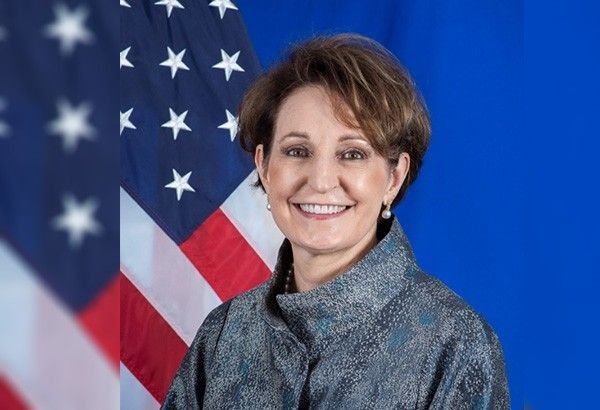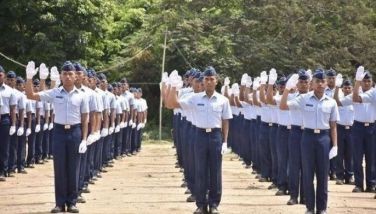Carlson on SCS aggression: We won’t let them prevail

MANILA, Philippines — The United States will not allow China to prevail with its illegal, coercive, aggressive and deceptive acts and give in to Beijing’s muscle flexing in the South China Sea, US Ambassador MaryKay Carlson said yesterday.
Carlson said the US is working with the Philippines to ensure that Philippine interests and international law are upheld.
She said that if the purpose of positioning “is to flex their muscle, maybe even doing so ahead of the US inauguration, we’re not going to cave to that.”
“We’re going to continue to work with our friends and partners, especially here in the Philippines. We’re going to continue to amplify the Philippines’ message. We’re going to continue to uphold international law,” Carlson said during her visit to The STAR.
The Philippines protested China’s deployment of its largest coast guard vessel, known as the “monster ship,” within the Philippines’ exclusive economic zone (EEZ), saying it is alarming and clearly intended to intimidate fishermen operating around a shoal in the contested waters of the South China Sea.
The ambassador stated that the US will push back on any attempts to circumvent international law through bullying practices.
“It’s illegal, coercive, aggressive and deceptive or what some people call gray zone tactics. We will not let them prevail,” Carlson said. “We’ll continue to expose them…
“The intent has been to flex muscle and we will continue to push back,” she added.
China was accused of pushing its South China Sea claims close to the Philippine coast to normalize its illegal grab of most of the waterway.
Common ground
The Philippines and China agreed to seek common ground and find ways to cooperate despite their disagreements in the South China Sea, their foreign ministries said on Thursday, as heated rows persist over vessels deployed around disputed features.
The two countries on Thursday held the 10th round of talks under a bilateral consultation mechanism set up to address issues in the South China Sea, where disputes have been frequent and tense, with ties at their lowest point in years.
Both countries said they agreed to advance coast guard and marine scientific cooperation and pledged to resolve issues peacefully.
“We firmly believe that despite the unresolved challenges and differences, there is genuine space for diplomatic and pragmatic cooperation in dealing with our issues in the South China Sea,” Foreign Affairs Undersecretary Theresa Lazaro said in her opening remarks at the 10th Bilateral Consultation Mechanism on the South China Sea in Xiamen, according to a statement.
China, through Vice Foreign Minister Chen Xiaodong, said it called on the Philippines to remain committed to resolving differences through dialogue and consultation.
Both agreed to boost communication and deepen dialogue, but also called out each other out over recent standoffs.
US ally the Philippines said it had expressed serious concern about the conduct of China’s coast guard, including its sustained presence in Manila’s exclusive economic zone.
China, for its part, said it lodged complaints over recent “maritime infringements and provocations” and for “hyping up” maritime disputes.
China’s expansive territorial claims in the key maritime trade route overlap with the EEZs of Brunei, Indonesia, Malaysia, the Philippines and Vietnam.
A 2016 ruling of an international arbitral tribunal said Beijing’s claims, based on its historic maps, have no basis under international law, a decision China does not recognize.
‘Monster ship’
At the dialogue in Xiamen, the Philippines also raised the presence and maritime activities, particularly that of CCG 5901 or “monster ship” and CCG 3103 in Philippine maritime zones that are inconsistent with the 1982 UNCLOS and the Philippine Maritime Zones Act.
The so-called monster ship of the China Coast Guard (CCG) remained inside the West Philippine Sea and is being driven away from the coastline of Zambales by a patrol vessel of the Philippine Coast Guard (PCG).
Last Jan. 15, CCG patrol ship 5901, with a length of 165 meters and weight of 12,000 tons, sent a radio challenge to PCG’s offshore patrol vessel BRP Gabriela Silang, stating it was “violating the Convention on the International Regulations for Preventing Collisions at Sea,” according to a video shared to reporters by Commodore Jay Tarriela, spokesman for the PCG on West Philippine Sea concerns.
He maintained the movements of the CCG vessel “have not been continuous or expeditious, failing to meet the necessary criteria for exercising the right of innocent passage.”
“In response, BRP Gabriela Silang has effectively maintained a protective position through skillful seamanship, successfully keeping the China Coast Guard at an average distance of 60-70 nautical miles from the Philippine coastline,” he pointed out.
Tarriela asserted CCG’s sustained presence in the West Philippine Sea – defined by the 2016 arbitral ruling, the United Nations Convention on the Law of the Sea, and Republic Act 12064 or the Maritime Zones Act – “disregards the more critical issue of the China Coast Guard’s illegal presence within the Philippines’ exclusive economic zone.”
The effort of Gabriela Silang to continuously follow CCG 5901 was “vital to prevent it from approaching the Zambales coast,” he added.
From Jan. 4 to 15, Tarriela has reported about CCG’s presence off the shores of Zambales 11 times, almost every night.
Indo-Pacific sky jump
Participating for the very first time, Philippine Army paratroopers joined their fellow airborne unit soldiers from at least 10 countries in this year’s New Year Indo-Pacific Jump held in Japan over the weekend.
The delegation, led by Army vice commander Maj. Gen. Leodevic Guinid, joined other allied nations in the event on Jan. 11 and 12 at the 1st Airborne Brigade, Japan Ground Self-Defense Force (JGSDF), Camp Narashino, Chiba prefecture.
Army spokesman Col. Louie Dema-ala said the Special Forces Regiment commander, Brig. Gen. Rosendo Abad Jr., also joined the airborne troopers in demonstrating Philippine Army’s military free fall and airborne capabilities, “manifesting the Philippine Army’s readiness to conduct airborne operations in special operations to support Territorial Defense Operations.”
Immediately following the aerial showcase were Simulated Air Assault Operations featuring the demonstration of the participating units from the United States Army, US Marine Corps, US Air Force, Singaporean Army, Australian Army, Royal Netherlands Army, French Army, Canadian Army, British Army, Polish Land Forces, Italian Army, German Army and 1st Airborne Brigade, JGSDF.
Dema-ala said the simulation showcased the capabilities and synchronized collaborations of the Indo-Pacific nations in addressing common threats or adversaries in the region.
According to him, the New Year Jump in Indo-Pacific in Japan has been held annually since 1974 to pray for the safety of airborne jumps throughout the year and foster greater understanding and confidence in the JGSDF.
He said the activity also aims to build relationships of trust, as well as to strengthen cooperation among the Airborne Forces and disseminate strategic messages to contribute to peace and stability in the Indo-Pacific region. - Ghio Ong, Michael Punongbayan
- Latest
- Trending






























